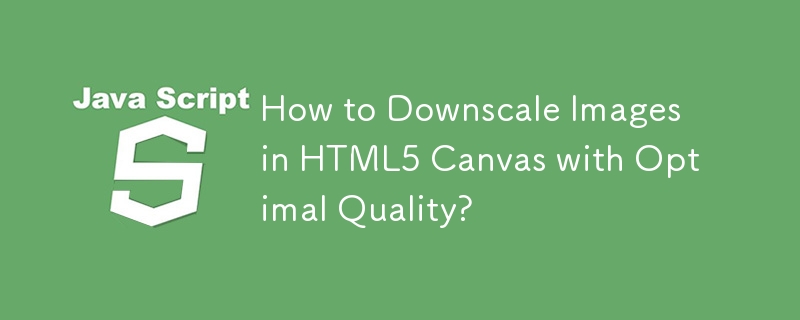How to Downscale Images in HTML5 Canvas with Optimal Quality?
Oct 25, 2024 am 06:40 AM
HTML5 Canvas Resize (Downscale) Image High Quality
In HTML5, you can use the canvas element to resize images, but the default downscaling method often results in low quality. Here are the steps to achieve optimal image quality when downscaling using canvas:
- Disable Image Smoothing: By default, browsers apply image smoothing to reduce jagged edges when resizing. However, this can blur the image. To disable image smoothing, set the following CSS property:
<code class="css">canvas, img {
image-rendering: optimizeQuality;
}</code>
- Preserve Aspect Ratio: Ensure that your canvas' aspect ratio matches that of the original image to prevent distortion.
- Use Pixel-Perfect Downscaling Algorithm: The default downscaling algorithm used by browsers often introduces noise. To address this, use a pixel-perfect downscaling algorithm that considers the contribution of multiple source pixels to each target pixel. Here's an example algorithm by GameAlchemist:
<code class="javascript">function downScaleImage(img, scale) {
// Implementation goes here...
}</code>
- Minimize Resampling Steps: Repeated downscaling steps introduce additional noise and degradation. If you need to downscale to a very small size, consider using multiple steps but with smaller scale increments to minimize distortion.
- Use a Large Source Image: To ensure that the downscaled image retains sharpness, it is recommended to use the largest possible source image.
- Modify Color After Resizing: If needed, you can modify colors within the canvas after resizing.
- Encode in High-Quality Format: When saving the downscaled image as a file, choose a high-quality format such as PNG or JPEG with high quality settings to preserve the image details.
Example Usage:
<code class="javascript">var img = document.createElement('img');
img.onload = function() {
var canvas = document.createElement('canvas');
canvas.width = 300;
canvas.height = 200;
var context = canvas.getContext('2d');
context.imageSmoothingEnabled = false;
context.drawImage(img, 0, 0, 300, 200);
var scaledImage = downScaleImage(canvas, 0.5); // Downscale by half
// Save or send the scaledImage using XMLHttpRequest
};
img.src = 'path/to/largeImage.jpg';</code>
By following these steps, you can downscale images in HTML5 canvas with optimal quality and preserve their details even when resizing to smaller sizes.
The above is the detailed content of How to Downscale Images in HTML5 Canvas with Optimal Quality?. For more information, please follow other related articles on the PHP Chinese website!

Hot AI Tools

Undress AI Tool
Undress images for free

Undresser.AI Undress
AI-powered app for creating realistic nude photos

AI Clothes Remover
Online AI tool for removing clothes from photos.

Clothoff.io
AI clothes remover

Video Face Swap
Swap faces in any video effortlessly with our completely free AI face swap tool!

Hot Article

Hot Tools

Notepad++7.3.1
Easy-to-use and free code editor

SublimeText3 Chinese version
Chinese version, very easy to use

Zend Studio 13.0.1
Powerful PHP integrated development environment

Dreamweaver CS6
Visual web development tools

SublimeText3 Mac version
God-level code editing software (SublimeText3)

Hot Topics
 Java vs. JavaScript: Clearing Up the Confusion
Jun 20, 2025 am 12:27 AM
Java vs. JavaScript: Clearing Up the Confusion
Jun 20, 2025 am 12:27 AM
Java and JavaScript are different programming languages, each suitable for different application scenarios. Java is used for large enterprise and mobile application development, while JavaScript is mainly used for web page development.
 Javascript Comments: short explanation
Jun 19, 2025 am 12:40 AM
Javascript Comments: short explanation
Jun 19, 2025 am 12:40 AM
JavaScriptcommentsareessentialformaintaining,reading,andguidingcodeexecution.1)Single-linecommentsareusedforquickexplanations.2)Multi-linecommentsexplaincomplexlogicorprovidedetaileddocumentation.3)Inlinecommentsclarifyspecificpartsofcode.Bestpractic
 How to work with dates and times in js?
Jul 01, 2025 am 01:27 AM
How to work with dates and times in js?
Jul 01, 2025 am 01:27 AM
The following points should be noted when processing dates and time in JavaScript: 1. There are many ways to create Date objects. It is recommended to use ISO format strings to ensure compatibility; 2. Get and set time information can be obtained and set methods, and note that the month starts from 0; 3. Manually formatting dates requires strings, and third-party libraries can also be used; 4. It is recommended to use libraries that support time zones, such as Luxon. Mastering these key points can effectively avoid common mistakes.
 JavaScript vs. Java: A Comprehensive Comparison for Developers
Jun 20, 2025 am 12:21 AM
JavaScript vs. Java: A Comprehensive Comparison for Developers
Jun 20, 2025 am 12:21 AM
JavaScriptispreferredforwebdevelopment,whileJavaisbetterforlarge-scalebackendsystemsandAndroidapps.1)JavaScriptexcelsincreatinginteractivewebexperienceswithitsdynamicnatureandDOMmanipulation.2)Javaoffersstrongtypingandobject-orientedfeatures,idealfor
 Why should you place tags at the bottom of the ?
Jul 02, 2025 am 01:22 AM
Why should you place tags at the bottom of the ?
Jul 02, 2025 am 01:22 AM
PlacingtagsatthebottomofablogpostorwebpageservespracticalpurposesforSEO,userexperience,anddesign.1.IthelpswithSEObyallowingsearchenginestoaccesskeyword-relevanttagswithoutclutteringthemaincontent.2.Itimprovesuserexperiencebykeepingthefocusonthearticl
 JavaScript: Exploring Data Types for Efficient Coding
Jun 20, 2025 am 12:46 AM
JavaScript: Exploring Data Types for Efficient Coding
Jun 20, 2025 am 12:46 AM
JavaScripthassevenfundamentaldatatypes:number,string,boolean,undefined,null,object,andsymbol.1)Numbersuseadouble-precisionformat,usefulforwidevaluerangesbutbecautiouswithfloating-pointarithmetic.2)Stringsareimmutable,useefficientconcatenationmethodsf
 What's the Difference Between Java and JavaScript?
Jun 17, 2025 am 09:17 AM
What's the Difference Between Java and JavaScript?
Jun 17, 2025 am 09:17 AM
Java and JavaScript are different programming languages. 1.Java is a statically typed and compiled language, suitable for enterprise applications and large systems. 2. JavaScript is a dynamic type and interpreted language, mainly used for web interaction and front-end development.
 What is event bubbling and capturing in the DOM?
Jul 02, 2025 am 01:19 AM
What is event bubbling and capturing in the DOM?
Jul 02, 2025 am 01:19 AM
Event capture and bubble are two stages of event propagation in DOM. Capture is from the top layer to the target element, and bubble is from the target element to the top layer. 1. Event capture is implemented by setting the useCapture parameter of addEventListener to true; 2. Event bubble is the default behavior, useCapture is set to false or omitted; 3. Event propagation can be used to prevent event propagation; 4. Event bubbling supports event delegation to improve dynamic content processing efficiency; 5. Capture can be used to intercept events in advance, such as logging or error processing. Understanding these two phases helps to accurately control the timing and how JavaScript responds to user operations.






